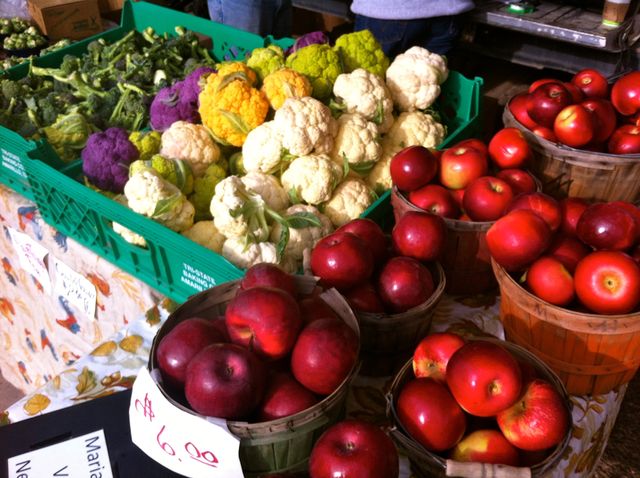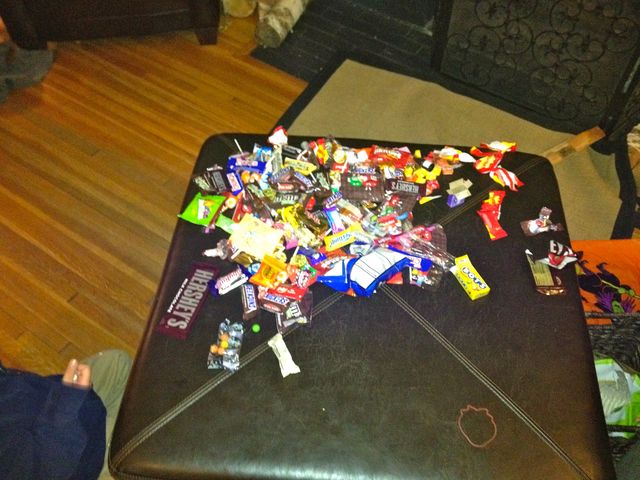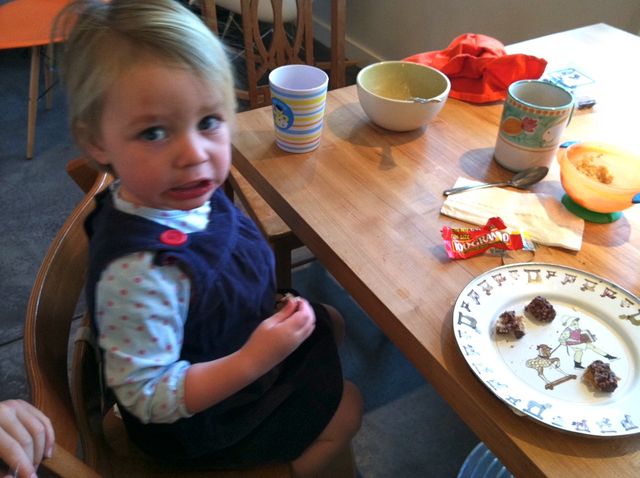By Elizabeth Eilers Sullivan

How many times have you heard yourself cajoling your kids with the phrase, Just take two more bites? Or, You can’t have dessert until you finish your meal? Depending on your child’s temperament and yours, you might inadvertently be doing two things: setting up a power struggle that can last until one of you caves, and teaching them to ignore their body’s signals.
What if you could change this practice so that eventually your child might leave a half-eaten cupcake on his plate, stating, “I’m full, thanks,” as he happily got up from the table? What if you could teach him to regulate his own intake of sugar, and, in turn, help him avoid the colds, mood swings, and lethargy that often comes with it? As the long, sugar-laden holiday season kicks into high gear this week, I decided to put this radical notion to the test.
Over the years, we’ve tried different strategies to control sugar consumption in our house. When our first son started eating solids, I fed him only organic food and avoided most processed foods and sweets. But as he got older I began to wonder if this approach wasn’t actually hindering his ability to self-regulate. And so, when he turned four, we decided to try something new. We let him eat his Halloween candy until he decided he was done. In the beginning, he'd eat 10 pieces a day for the first few days and then he would start to save his candy—often it would last several months. I wanted him to understand what a sugar crash felt like, and I knew my explanation couldn’t replace his own experience of such a sensation. This strategy still works well for him now that he's seven, but it doesn't for our five-year-old, who seems to have an insatiable sweet tooth. The allure of holiday treats is so great it overrides his natural self-restraint. He could feast on candy and never stop eating it. He would choose sugar over all kinds of other food.

is a therapist, author, and��international expert on feeding and eating who believes that children are born with an innate wisdom about food: Babies will eat what they need and stop when they are full. If you observe their eating habits, you’ll probably notice that they’re eating a balanced diet over the long term, even if it doesn’t appear all that balanced in a single day. To help older kids tap into these healthy natural instincts, she recommends delegating responsibilities at mealtime. Parents decide what, where, and when kids eat. Kids decide if and how much they eat. To achieve this, serve meals family style let the kids take as much, or as little, as they want. “The secret to feeding a healthy family is to love good food, trust yourself, and share that love and trust with your child,” says Satter. “When the joy goes out of eating, nutrition suffers.”
What I’ve learned after years of mindlessly eating deep-dish pizzas, lots of pasta, and other foods heavy with carbs is that when I eat healthy, whole foods, I feel better. But do my kids know this? Have I given them the opportunities to test this hypothesis? And am I setting them up to internalize a “these foods are good and those foods are bad” mentality at a young age when black-and-white thinking is at its peak? Are my young children somehow equating what they eat with who they are as individuals? While I don’t like my kids eating sugar, I do want them to be able to manage it. I want to help them realize the effect sugar, sweets, and candy have on their body, their brain, and their decisions. I will not always be there to encourage them to eat well. It’s a habit they need to internalize.
, a family doctor turned childhood-feeding specialist and author of��, offers great wisdom about how to take the fear out of eating and put the intuition back in. In her book, she writes: “sweets, candy, and desserts are limited and treated differently than other foods. This is the one area where��the adult decides��how much. Why? Because sweets are so appealing that they are difficult to learn to manage without a little more direction. If a child is allowed unlimited sweets with every meal and snack, the sweets tend to displace more nutritious foods, making variety and balanced eating more difficult. However, in order to deal with the potential “forbidden-food” phenomena, where the child becomes unduly interested in sweets, the child needs fairly frequent opportunities to learn to handle ‘forbidden foods.’”

How? Try these five tips:
STOP DEMONIZING SWEETS
Says Rowell: “From a developmental standpoint, kids are very logical up until the age of 11. They tend to think that if I enjoy a sugary, sweet, good-tasting food that my parents label as bad, then I must be bad. This is the beginning of internalizing messages about food. Fear and avoidance around desserts and food often leads to sneaking, binge eating, secrets, and shame.” Think of this as an invitation to stop calling some food junk and others healthy. Research tells us kids and adults eat foods because of taste first. Telling kids food is “healthy” puts undue pressure on them to eat it, and many may push back as a result. It also sends a signal that it must not taste very good, otherwise why the��nutrition sell? Of course, this is age��sensitive. You might talk to an 11-year-old about nutrition very differently than a four-year-old. Still, do your best to keep it neutral. As Rowell says, “Make food, food.”
EAT SWEETS ALL YEAR
Don’t limit sugary treats to the holidays. Make managing sweets a year-long practice. That way, when the six-week-long Halloween-to-Christmas sugar insanity hits, your kids will be better able to manage it and you will have less anxiety and fear around the extra sweets. Coming off the sugar crash of Halloween, I’m already feeling less stressed about the annual power struggle over holiday candy, cakes, and sugary sweets.

DE-MYSTIFY DESSERT
Here’s a bold idea: Serve cake with dinner and��take the power out of dessert. Rowell explains: “This way of feeding kids supports the internal wisdom babies are born with instead of burying the skill that tells them what they need and when they are full. If you have wielded dessert as a tool for getting veggies in, it will take him a while to understand. He will eat dessert first, for a few days or even weeks, but eventually you will see him lick a Popsicle, maybe eat a bite of chicken, then lick the Popsicle and poke at a carrot. This process may take some time, and things will seem worse before they get better.”
SERVE TREATS AS SNACKS
“About one to two times a week, offer a snack in which a treat or formerly forbidden food (FFF) is included, and he can eat as much as he wants. When I get a call from a parent whose child is sneaking certain foods like candy or cookies, we have to find ways of bringing those high-interest foods into the meal and snack rotation.��It can be scary, because if your child has been limited and is craving and sneaking the FFF, she will eat lots of it initially. She may eat so much she even makes herself sick. This is part of learning how to manage the foods. Hovering and warning her not to eat too many is not the point. Start with something that feels safer, like homemade oatmeal-raisin cookies with milk. Allow her to lick the spoon. Sit down and enjoy it with milk. You can serve them with a favorite fruit so she has the option of getting a little more balance. I recommend trying to offer some fat and protein as well, which is why one or two percent milk is so nice. With time, you should see your child eat a little less, perhaps more slowly, and possibly choosing a banana or other options. I remember being amazed after we did this for a while that my daughter, after one or two Rice Krispies treats, milk, and half a kiwi, would stop. Just like that.”
RELAX AND ENJOY
Lastly, Rowell invites us as parents to “give permission to eat the food and enjoy the food. This puts the joy back into eating and takes the shame out of eating.” After all, food is not just about nourishment—it is about joy and emotion, and community. “Making a meal,” she says, “is like serving love on a plate.”��
So this holiday season, try it. Decide what your child eats, when your child eats, and where your child eats, and let them choose if they eat and how much of it they eat. Go ahead and include dessert at the onset of the meal. See what happens. And make this a habit not only for the holidays but afterward and see them eventually leave that half-eaten cupcake on their plate, claiming the ever amazing words, “I’m full,” as they happily excuse themselves.��I, for one, am ready to give this a go all year long.
Elizabeth Eilers Sullivan is a writer in St. Paul, Minnesota,
where she lives with her husband and four young sons.